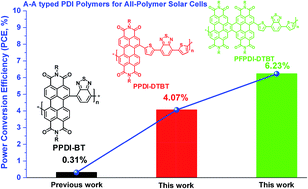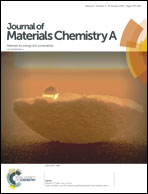Novel perylene diimide-based polymers with electron-deficient segments as the comonomer for efficient all-polymer solar cells†
Abstract
Two novel acceptor–acceptor (A–A) type polymer electron acceptors, PPDI-DTBT and PFPDI-DTBT, which contain perylene diimide (PDI) and fused PDI (FPDI) with electron deficient 4,7-dithienyl-2,1,3-benzothiadiazole (DTBT) units, respectively, are designed and synthesized to investigate their application in all-polymer solar cells (all-PSCs). With a narrow band-gap polymer, PTB7-Th, as the polymer donor, all-PSCs based on PTB7-Th:PPDI-DTBT showed a promising power conversion efficiency (PCE) of 4.07%, whereas the photovoltaic performance of PTB7-Th:PFPDI-DTBT was further improved with a PCE of 6.23%, which is the best device performance (ca. 75% higher) for all-PSCs of PDI-based A–A type polymer acceptors reported so far. Their optical, electrochemical, photoluminescence and charge transport properties were investigated to illustrate the difference in the photovoltaic performance. The results open a design strategy of PDI-based A–A type polymer electron acceptors through modifying the polymer structure to restrict molecular chain interactions to achieve high performance all-PSCs.

- This article is part of the themed collection: 2018 Journal of Materials Chemistry A HOT Papers


 Please wait while we load your content...
Please wait while we load your content...